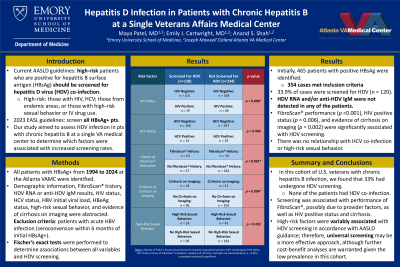Sunday Poster Session
Category: Liver
P1207 - Hepatitis D Infection in Patients With Chronic Hepatitis B at a Single Veterans Affairs Medical Center
Sunday, October 27, 2024
3:30 PM - 7:00 PM ET
Location: Exhibit Hall E

Has Audio

Maya Patel, MD, MS
Emory University School of Medicine
Atlanta, GA
Presenting Author(s)
Maya Patel, MD, MS1, Emily Cartwright, MD2, Anand S.. Shah, MD2
1Emory University School of Medicine, Atlanta, GA; 2Emory University School of Medicine, Decatur, GA
Introduction: Current AASLD practice guidelines recommend that high-risk patients who are positive for hepatitis B surface antigen (HBsAg) be screened for hepatitis D (HDV) co-infection. High-risk patients include those with human immunodeficiency virus (HIV) or hepatitis C (HCV) infection, those from HDV endemic areas, people with a history of intravenous drug use, or those with high-risk sexual behavior (including men who have sex with men or patients with multiple sexual partners). The 2023 EASL practice guidelines recommend screening for HDV in all patients who are HBsAg positive. Given these updates, our study aimed to assess HDV infection in patients with chronic hepatitis B at a single Veterans Affairs Medical Center and determine which factors were associated with HDV screening.
Methods: We identified all patients with positive HBsAg at our institution from 1994 to 2024 using a comprehensive dataset that included demographic information, Fibroscan history, and HDV RNA or anti-HDV IgM results. We excluded patients with acute HBV infection (seroconversion within 6 months of initial +HBsAg) and those with incomplete information regarding chronicity of infection. Other variables such as HIV status, HCV status, HBV initial viral load, HBeAg status, high-risk sexual behavior, and evidence of cirrhosis on imaging were then abstracted from the electronic medical record. Fischer’s exact tests were performed to determine associations between all variables and HDV screening.
Results: Initially, 465 patients with positive HBsAg were identified and 354 cases met the inclusion criteria. Of these cases, 33.9% (n=120) were screened for HDV, and none of the patients tested positive. Fibroscan performance (p < 0.001), HIV positive status (p = 0.006), and evidence of cirrhosis on imaging (p = 0.002) were significantly associated with HDV screening. There was no relationship with HCV co-infection or high-risk sexual behavior.
Discussion: In a cohort of U.S. veterans with chronic HBV infection, we found that 33% had undergone HDV screening. Ultimately, none of these patients had HDV co-infection. Screening was associated with performance of Fibroscan, possibly due to provider factors, as well as HIV positive status and evidence of cirrhosis on imaging. High-risk factors were variably associated with HDV screening in accordance with AASLD guidance. Therefore, universal HDV screening may be a more effective approach, although further cost-benefit analysis should be considered given the low prevalence in this cohort.
Note: The table for this abstract can be viewed in the ePoster Gallery section of the ACG 2024 ePoster Site or in The American Journal of Gastroenterology's abstract supplement issue, both of which will be available starting October 27, 2024.
Disclosures:
Maya Patel, MD, MS1, Emily Cartwright, MD2, Anand S.. Shah, MD2. P1207 - Hepatitis D Infection in Patients With Chronic Hepatitis B at a Single Veterans Affairs Medical Center, ACG 2024 Annual Scientific Meeting Abstracts. Philadelphia, PA: American College of Gastroenterology.
1Emory University School of Medicine, Atlanta, GA; 2Emory University School of Medicine, Decatur, GA
Introduction: Current AASLD practice guidelines recommend that high-risk patients who are positive for hepatitis B surface antigen (HBsAg) be screened for hepatitis D (HDV) co-infection. High-risk patients include those with human immunodeficiency virus (HIV) or hepatitis C (HCV) infection, those from HDV endemic areas, people with a history of intravenous drug use, or those with high-risk sexual behavior (including men who have sex with men or patients with multiple sexual partners). The 2023 EASL practice guidelines recommend screening for HDV in all patients who are HBsAg positive. Given these updates, our study aimed to assess HDV infection in patients with chronic hepatitis B at a single Veterans Affairs Medical Center and determine which factors were associated with HDV screening.
Methods: We identified all patients with positive HBsAg at our institution from 1994 to 2024 using a comprehensive dataset that included demographic information, Fibroscan history, and HDV RNA or anti-HDV IgM results. We excluded patients with acute HBV infection (seroconversion within 6 months of initial +HBsAg) and those with incomplete information regarding chronicity of infection. Other variables such as HIV status, HCV status, HBV initial viral load, HBeAg status, high-risk sexual behavior, and evidence of cirrhosis on imaging were then abstracted from the electronic medical record. Fischer’s exact tests were performed to determine associations between all variables and HDV screening.
Results: Initially, 465 patients with positive HBsAg were identified and 354 cases met the inclusion criteria. Of these cases, 33.9% (n=120) were screened for HDV, and none of the patients tested positive. Fibroscan performance (p < 0.001), HIV positive status (p = 0.006), and evidence of cirrhosis on imaging (p = 0.002) were significantly associated with HDV screening. There was no relationship with HCV co-infection or high-risk sexual behavior.
Discussion: In a cohort of U.S. veterans with chronic HBV infection, we found that 33% had undergone HDV screening. Ultimately, none of these patients had HDV co-infection. Screening was associated with performance of Fibroscan, possibly due to provider factors, as well as HIV positive status and evidence of cirrhosis on imaging. High-risk factors were variably associated with HDV screening in accordance with AASLD guidance. Therefore, universal HDV screening may be a more effective approach, although further cost-benefit analysis should be considered given the low prevalence in this cohort.
Note: The table for this abstract can be viewed in the ePoster Gallery section of the ACG 2024 ePoster Site or in The American Journal of Gastroenterology's abstract supplement issue, both of which will be available starting October 27, 2024.
Disclosures:
Maya Patel indicated no relevant financial relationships.
Emily Cartwright indicated no relevant financial relationships.
Anand Shah indicated no relevant financial relationships.
Maya Patel, MD, MS1, Emily Cartwright, MD2, Anand S.. Shah, MD2. P1207 - Hepatitis D Infection in Patients With Chronic Hepatitis B at a Single Veterans Affairs Medical Center, ACG 2024 Annual Scientific Meeting Abstracts. Philadelphia, PA: American College of Gastroenterology.
